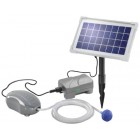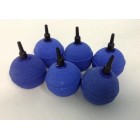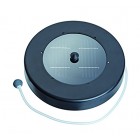Shopping Cart
0 item(s) - £0.00- Accessories
- Aeration & Air Pumps
- Algae Control
- Aquatic Plants, Floating Islands & Pond Planters
- Assorted Water Treatments
- Bacteria
- Barley Straw
- Birding, Bird Baths, Feeders & Bird Watching
- Blanket Weed & Algae Control
- Books & Pond Guides
- Complete Pond Kits
- Diffusers & Airstones
- Dyes & Colorants
- Filters, UV Clarifiers & Skimmers
- Fish Care
- Fountains
- Lighting
- Liner, Membranes & Pre-Formed Ponds
- Muck & Sludge Removal
- Natural Earth Ponds & Lakes
- Predator Control
- Pumps
- Replacement Parts
- Solar & DC Ponds & Pumps
- Spillways & Waterfall Weirs
- Spitters
- Tubing & Hoses
- Winterizing
- Commercial & Industrial UK
- Shop by Manufacturer
Aeration & Air Pumps

Ponds and watergardens are miniature ecosystems that contain all forms of life, including the plants, animals and bacteria. All these living organisms require oxygen; that is why It is necessary to maintain an adequate concentration of oxygen in the water to preserve the health of the ecosystem of the pond.
A healthy pond provides water first quality The expulsion of fine bubbles of air from the bottom of the pond causes thoroughly mix the pond by breaking the thermal stratification the water column. The movement of water that is created exposes, level the surface, bacteria that are so destroyed by the action of radiation UV from the Sun.
Aeration can also contain algal populations since it prevents of an anoxic layer at the water-sediment interface and, in doing so, it prevents the release of phosphorus present in the bottom of the pond, which makes it less available for algae and thus limit the development. Finally, aeration also prevents the solubilization of iron from the sediments and, consequem- ment, reduces damage to equipment or equipment-related problems.
All plants and animals use oxygen to breathe. However, it is the decomposition of the organic material to the bottom of dugouts that consumes the most of oxygen. When plants and animals die, they fall to the bottom and decompose. This process of decomposition consumes large quantities oxygen, which explains that it is at the bottom of the pond the concentration of oxygen is low.
Refine Search
Atlantic Pond Supply UK - Serving the UK Since 2004
UK Pond Supply in Great Britain, Scotland, Wales & Ireland

Pond Supplies in England serving:
Avon – Bedfordshire – Berkshire – Bristol – Buckinghamshire – Cambridgeshire – Cambridgeshire and Isle of Ely – Cheshire – Cleveland – Cornwall – Cumberland – Cumbria – Derbyshire – Devon – Dorset – Durham – East Suffolk – East Sussex – Essex – Gloucestershire – Greater London – Greater Manchester – Hampshire – Hereford and Worcester – Herefordshire – Hertfordshire – Humberside – Huntingdon and Peterborough – Huntingdonshire – Isle of Ely – Isle of Wight – Kent – Lancashire – Leicestershire – Lincolnshire – London – Merseyside – Middlesex – Norfolk – Northamptonshire – Northumberland – North Humberside – North Yorkshire – Nottinghamshire – Oxfordshire – Soke of Peterborough – Rutland – Shropshire – Somerset – South Humberside – South Yorkshire – Staffordshire – Suffolk – Surrey – Sussex – Tyne and Wear – Warwickshire – West Midlands – Westmorland – West Suffolk – West Sussex – West Yorkshire – Wiltshire – Worcestershire – Yorkshire
Pond supplies in Ireland serving:
Antrim – Armagh – Belfast – Down – Fermanagh – Londonderry – Tyrone
Pond Supplies in Scotland serving:
Aberdeen – Aberdeenshire – Angus – Argyll – Ayrshire – Banffshire – Berwickshire – Bute – Caithness – Clackmannanshire – Cromartyshire – Dumfriesshire – Dunbartonshire – Dundee – East Lothian – Edinburgh – Fife – Glasgow – Inverness-shire – Kincardineshire – Kinross-shire – Kirkcudbrightshire – Lanarkshire – Midlothian – Moray – Nairnshire – Orkney – Peeblesshire – Perthshire – Renfrewshire – Ross and Cromarty – Ross-shire – Roxburghshire – Selkirkshire – Shetland – Stirlingshire – Sutherland – West Lothian – Wigtownshire – Wales
Pond Supplies in Wales serving:
Anglesey – Brecknockshire – Caernarfonshire – Cardiganshire – Carmarthenshire – Clwyd – Denbighshire – Dyfed – Flintshire – Glamorgan – Gwent – Gwynedd – Merionethshire – Mid Glamorgan – Monmouthshire – Montgomeryshire – Pembrokeshire – Powys – Radnorshire – South Glamorgan – West Glamorgan

Pond & water garden products in the UK.
Fast and often free shipping across the United Kingdom from Amazon.co.uk fulfillment warehouses.

Atlantic Pond Supply USA | Atlantic Pond Supply CANADA
© 2004 - 2025


























